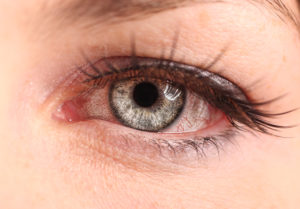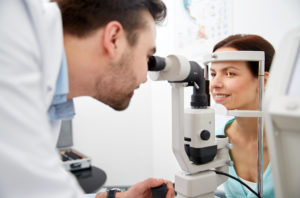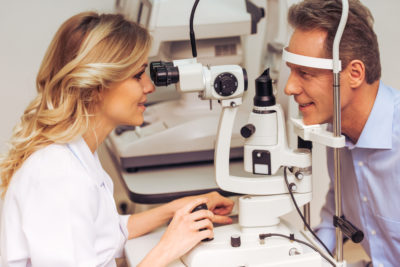Everything You Need To Know About Pink Eye

Chances are you or someone you know has dealt with an irritating, common eye condition known as pink eye or conjunctivitis. If you have never had any first-hand experience with the side effects of pink eye, it is when your eye becomes infected and can be caused by a virus, bacteria, or an allergy. Pink eye gets its name because when you become infected your eyes become irritated and turn pink and swollen as a result.
Some other symptoms of pink eye include but are not limited to:
- Redness
- Irritation
- Redness of eyelid
- Discharge
- Gritty feeling
- Itchiness
- Puffy eyes
- Swollen lining of eyes
- Watery eyes
If you experience one or more of these symptoms it is important to schedule an appointment for a diagnosis which will allow you to get proper treatment. This is important because pink eye is a very contagious condition that can easily be passed from person to person.
You can become infected with pink eye as a result of a viral or bacterial infection as well as an allergy. The most common cause of pink eye is from a virus. People get pink eye as a result of a virus from things like the common cold, flu, respiratory infection and many others. Another way you can become infected with pink eye is from an allergic reaction, this can come from pollen, dust, contact lenses, cosmetics, and many other things. It is important to understand the signs and symptoms of this eye condition so that you can understand your treatment options and prevent spreading.

It is important to ensure that you are eating foods that are good for your overall health as well as your eye health! I’m sure you’ve heard to eat more carrots if you want strong eyes or fill your diet with leafy greens but what are you eating that could be harming your eye health? Since your eyes are vascular it is important to have a diet that is heart healthy in order to keep them on their A game! Don’t worry, we’ve got you covered – here are 3 things in your diet that are damaging your eye health!
Sweetened Drinks
The first thing in your diet that will contribute to negative eye health is sweetened drinks. These sweetened drinks are unhealthy for your eyes because they have a negative impact on your blood pressure level. The source of these sugars commonly comes from additives such as high fructose corn syrup, which raises your blood pressure. In addition to an effect on your blood pressure level, these sugary drinks also increase your triglyceride level making them a poor choice for a heart-healthy and eye-friendly diet.
Processed Foods
Consuming a diet that is high in processed foods has a negative impact on multiple aspects of your health, including your vision. These foods are full of additives that negatively impact your overall health and take a toll on your cardiovascular health. By limiting the number of processed foods, you consume you can help keep your eyes healthy and prevent many eye diseases such as macular degeneration.
Margarine
Nutritionists have stated that margarine is a source of unhealthy trans fatty acids which increases your chance of developing a cardiovascular disease. The processing and chemicals that are used to make margarine can lead to clogged arteries putting your eyes, heart, and whole body at risk.
By cutting back or cutting these 3 things out of your diet you can decrease your chances of developing an eye disease such as macular degeneration, cataracts and many more!

There are many steps you can take to keep your body healthy, including your eye health and vision. There are many factors that contribute to your eye health and these are a couple ways you can protect your vision!
Eat Healthy:
It is no secret that what we fuel our body with has an effect on every aspect of our health. To keep your eyes on their A game it is important to keep your diet rich in many things including Lutein, Zinc, Omega-3 Fatty Acids, and Vitamins C and E.
Some examples of food you can eat to fill your diet with these nutrients are:
- Fish (salmon, tuna, mackerel)
- Nuts & Seeds (walnuts, flaxseed, chia seeds)
- Whole Grains (brown rice, whole wheat pasta, quinoa)
- Leafy Greens (kale, spinach, collards)
- Citrus Fruits & Vegetables
Stay Hydrated:
It is important to keep your body not only fueled by the right food but plenty of water. Your eyes can only properly function when they have plenty of fluid that is keeping them hydrated. When you become dehydrated you can run into issues with tear production which will result in dry eyes. Drinking at least eight ounces of water every few hours is an easy way to keep hydration at the front of your mind. One way to make sure you are drinking water throughout the day is to keep a water bottle handy, filling it up whenever it may be getting low.
Wear Sunglasses:
Wearing sunglasses outside helps protect your eyes from the damaging ultraviolet (UV) rays that come from the sun. The longer that your unprotected eyes are exposed to UV rays the higher your chances of developing cataracts or macular degeneration later in your life are. When buying a new pair of sunglasses, it is important to make sure that they block out 99 to 100 percent of both UV-A and UV-B radiation.
Quit Smoking:
It is well known that smoking is the leading cause of serious health conditions that affect your lungs, heart, and much more. What most people don’t know is how smoking negatively impacts your eyes and puts you at an increased risk of developing cataracts, diabetic retinopathy, age-related macular degeneration, and dry eye syndrome. It is important to know the risks that are associated with smoking when it comes to your total health, including your eyes. By quitting smoking, you can help reduce your risks of developing one of these eye conditions!

Life gets busy and sometimes we forgot about appointments, it happens. So, if you are sitting there trying to remember when the last time you had your eyes checked – you aren’t alone. Your health is important, and it is crucial to take care of your eyes. So, when do you know it’s time to get your eyes checked?
There are several reasons why you should schedule an appointment to get your eyes examined. The first reason being the amount of time since your last appointment. Depending on your age and eye history the number of times you need to see the eye doctor will vary. Ideally, for someone under the age of 40, we suggest that you get at least one eye exam every 1-2 years if you have no previous eye complications. It is also suggested that people under the age of 50 who have eye health history such as infections, diabetes, glasses/contacts, surgery etc. to get their eyes checked at least once every year if not more frequently.
If you have any health conditions that affect your vision such as diabetes, family history, smoking, etc. it is important to attend eye exams in order to make sure that you are not at risk at any complications. By doing this you can stay on top of your eye health and make sure you are getting the proper care you need. If you are over the age of 50 and have a history of eye health problems it may be important for you to visit the eye doctor more than once a year.
Another reason why you may need to get an eye exam is if you are experiencing unusual symptoms or signs. Some of these symptoms could include:
- Itchy, Dry Eyes
- Seeing Spots, Floaters, or flashes of light
- If you are experiencing eye strain, headaches from prolonged computer/device use
- You think your prescription may have changed (blurry vision, trouble reading/seeing)
- Possible Infection
Any of these symptoms are important to be looked at to rule out any possible infections. Your eyes serve an important purpose to your overall well-being so it is vital to stay on top of your eye health and schedule an appointment today!

As we get older we start thinking more and more about health and conditions we may be prone to getting. This is something you think about a lot when thinking about your eye health in particular. One condition that can start to develop as you get older is Primary Open-Angle Glaucoma. This is the most common type of glaucoma and it occurs gradually over time. When you have this condition, your eye does not drain fluid as well as it should, similar to a clogged drain. Because of this the eye pressure continuously builds up and this starts to cause damage to your optic nerve. This type of glaucoma is painless and causes no vision changes at first which is why it is commonly overlooked and not detected immediately.
Since Primary Open-Angle Glaucoma starts out with minimal to no warning signs or symptoms it is vital that you are having your eyes regularly examined. Eye exams are always important but become increasingly important as you age and could start developing these sometimes silent conditions. A regular eye exam will allow you to detect Glaucoma sooner and give you time to protect your vision. This is important to keep in mind because in the United States alone Glaucoma has left 120,000 blind.
Now that you know what Primary Open-Angle Glaucoma is and how severe it can be if it goes unrecognized it is important to take the next steps to protect yourself from this condition that could leave you blind. You can do this by scheduling an eye exam regularly to detect any warning signs of this condition as well as numerous other conditions that can negatively impact your eye health.

It is well known that smoking is the leading cause of serious health conditions that affect your lungs, heart, and much more. What most people don’t know is how smoking negatively impacts your eyes and puts you at an increased risk of developing cataracts, diabetic retinopathy, age-related macular degeneration, and dry eye syndrome. Read more about how smoking increases the risks of developing these conditions.
Cataracts is an eye disease that causes your natural lens to cloud. Studies have shown that smoking doubles your chances of developing cataracts. These chances continue to rise as you smoke more and more. Right now Cataracts is the leading cause of blindness in the world and smoking only continues to put you at a higher risk of developing a Cataract.
Diabetic Retinopathy is a condition that occurs when there is damage to the blood vessels in the tissue at the retina. This disease occurs in people who suffer from diabetes and is the leading cause of vision loss in people who are dealing with diabetes. By smoking, you’re twice as likely to develop diabetes which puts you at risk for Diabetic Retinopathy, as well as numerous other diabetes complications.
Age-Related Macular Degeneration (AMD) is when your macula, the small center of the retina starts to deteriorate. When this part of your eye starts to deteriorate you start to lose your sharp, central vision making it difficult to do everyday tasks. Smoking puts you at three times the risk of developing Age-Related Macular Degeneration.
Dry Eye Syndrome occurs when your eyes aren’t producing enough tears to lubricate the eye. Smoking cigarettes is known to cause dry eye because the smoke is a well-known eye irritant. When your eyes are exposed to tobacco smoke it increases your symptoms of Dry Eye which include eye redness and itchiness.
It is important to know the risks that are associated with smoking when it comes to your total health, including your eyes. By quitting smoking you can help reduce your risks of developing one of these eye conditions!

We fuel our body with foods for our overall health but have you ever put in any thought about which foods have the best impact on our eye health? We are here to help! Check out which food groups will help keep you and your eyes healthy!
Fish, Nuts & Seeds: The first suggestion we have for you is to consume foods that contain omega 3 fatty acids! It is important to get a general intake of omega 3 fatty acid because of the overall health benefits you get. These benefits include maintaining cardiovascular health by lowering blood pressure, cholesterol levels, and triglyceride levels. Not only are omega 3 fatty acids good for the rest of your body they are also great for your eyes. It is proven that they can help with dry eyes, macular degeneration, and cataracts. Some foods that you can eat to ensure you are getting this nutrient are Fish such as salmon, tuna, mackerel as well as nuts and seeds like walnuts, flaxseed, and chia seeds.
Whole Grains: Keeping your diet rich in whole grains can be beneficial to your overall health as well as your eye health! By substituting white flour products with whole grain options such as brown rice, whole wheat pasta, quinoa you can help reduce your risk of age-related macular degeneration.
Leafy Greens: It is vital to your eyesight that you have a diet that is rich in Lutein and Zeaxanthin. These nutrients help keep your eyes on their A game. Some foods that would fall under this category and give you the nutrients you need would be kale, spinach, collards, as well as a number of other greens.
Citrus Fruits and Veggies: Keep your diet rich by fueling your body with an assortment of citrus fruits and berries! This gives your body the Vitamin A and C that it needs and helps keep your eyes in the best shape. Vitamin A and C have proven to be very beneficial for your eye health and by keeping your diet full of them your eyes will thank you! Some examples of common foods you could eat to get your fix of Vitamin A and C are oranges, grapefruit, apricots, plums, carrots, peppers, and many others.
